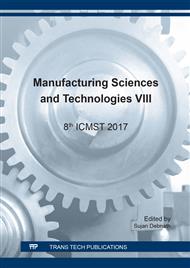p.71
p.77
p.83
p.88
p.95
p.100
p.107
p.112
p.118
Optimal Parameter Design of Rice Milling Machine Using Design of Experiment
Abstract:
This study was aimed at finding appropriate levels of machine set up for small-sized rice milling machine in order to improve rice milling effectiveness. Small rice milling machines are used by farmers to reduce the reliance on commercial rice mill. However, they are found to produce greater quantities of broken rice grains than large-sized rice milling machine. This study investigated three factors of machine setup that would lead to smallest percentage of broken rice grains, i.e. size of hopper feed, gap adjuster, and outlet regulator. Each factor had three levels thus 3 x 3 factorial design was used to investigate the factors. It was found that all the three factors had significant impact on the number of broken grains. The optimum parameter settings that led to the smallest percentage of broken rice grains were as follows: size of hopper feed at 12 cm2, gap adjuster at 5 mm, and outlet regulator at 5 cm.
Info:
Periodical:
Pages:
107-111
Citation:
Online since:
January 2018
Authors:
Price:
Сopyright:
© 2018 Trans Tech Publications Ltd. All Rights Reserved
Share:
Citation:


